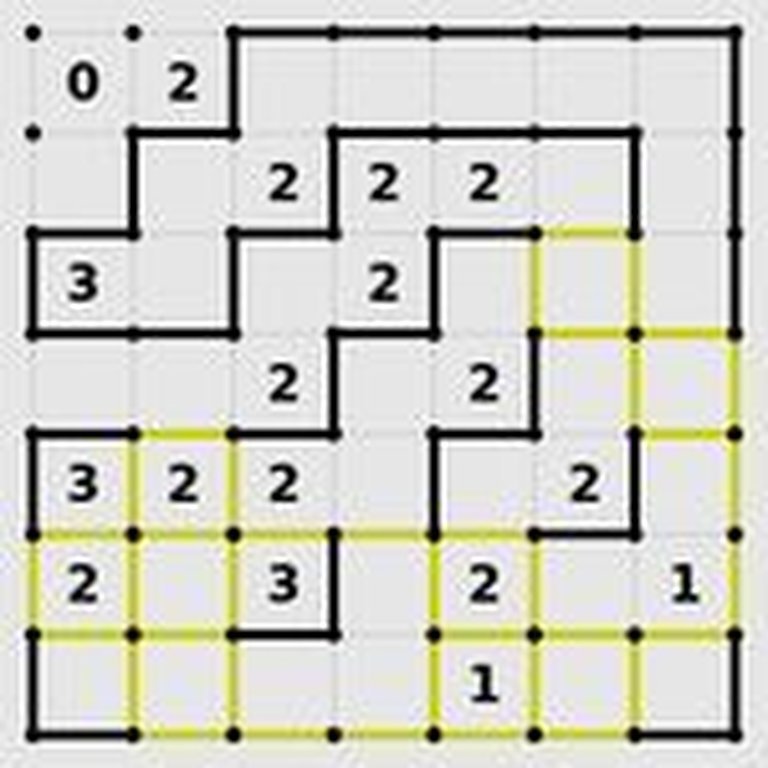- Release Year: 2005
- Platforms: Browser, Windows
- Publisher: Simon Tatham’s Portable Puzzle Collection
- Developer: Lambros Lambrou, Mike Pinna
- Genre: Puzzle
- Perspective: Top-down
- Game Mode: Single-player
- Gameplay: Grid-based, Loop drawing, Number logic

Description
Loopy is a grid-based puzzle game where players draw a single closed loop using the edges of grid squares. Some squares contain numbers indicating how many edges belong to the loop, challenging players to solve puzzles across various grid sizes and shapes. Part of Simon Tatham’s Portable Puzzle Collection, Loopy offers a variety of configurations to test logic and spatial reasoning.
Where to Buy Loopy
PC
Loopy Cheats & Codes
Casio Loopy
| Code | Effect |
|---|---|
| Hold L + R + D + Right, press Reset | Displays text that translates to “Lupiton memory clear.” |
| Hold L + R, press Reset | Displays version history. |
Loopy: Review
Introduction
Loopy is a deceptively simple yet deeply engaging grid-based puzzle game that challenges players to draw a single closed loop through a grid. Created as part of Simon Tatham’s Portable Puzzle Collection, this gem of a game exudes a timeless charm born from its elegant rules and endless replayability.
Development History & Context
Conceived by puzzler Mike Pinna and enhanced by Lambros Lambrou, Loopy was inspired by Nikoli’s classic loop-based puzzles. Part of Simon Tatham’s vision of creating cross-platform puzzle collection, Loopy was released in 2005 for Windows and later adapted for browser play. Its development came at a time when the internet was democratizing game distribution, allowing niche puzzle experiences like this to find audiences beyond traditional channels.
The game’s creators harnessed the era’s brief机遇 (opportunity) to push beyond square grids into various shapes like hexagons and triangles, showcasing a knack for innovation while maintaining the core puzzle integrity. As browser-based gaming gained traction, Loopy’s adaptability ensured it remained accessible to casual and dedicated players alike, exemplifying both the constraints and possibilities of early 2000s game design.
Narrative & Thematic Deep Dive
Though Loopy eschews traditional storytelling, the act of solving each puzzle is itself a narrative journey. As players construct the loop, each decision leads them closer to the satisfying conclusion where all numbers align. Underlying themes of connectivity, containment, and cyclical structures emerge, providing a meditative yet mentally stimulating experience.
Metaphorically, the loop represents a harmonious state where every part of the grid contributes to the whole. The numbers act as instinctual guides, prompting players to navigate through choice and consequence, much like life’s repeated patterns. Whether viewed as a chessboard of abstract strategy or a canvas for logical expression, LoopyDistance invigorates and relaxes the mind in equal measure.
Gameplay Mechanics & Systems
At its core, Loopy demands that players draw a single continuous loop through a grid of squares (or other shapes), with certain cells indicating how many of their four edges must be part of the loop. The mechanics are disarmingly simple: click to toggle edges, connect the dots, and ensure no branches or dead ends exist.
The game’s depth lies in its grid variations, including different sizes and polygon types. This diversity challenges players to adapt their strategies, whether visualizing paths across hexagonal grids or handling the increased complexity of larger square grids. The user interface is clean and minimal, allowing intuitive interaction and easy navigation between puzzles.
Akin to the best puzzle games, Loopy’s design enforces logical deductedS thinking rather than trial-and-error. Each numbered cell provides clues, leading players through a dance of inclusion and exclusion. This focus on logical flow creates a deeply satisfying gameplay loop where every correct edge feels like a step towards enlightenment.
Possible areas for improvement might include more progressive difficulty scaling or additional tutorial content for non-square grids. However, the game’s essence remains intact, offering countless hours of engrossing puzzling.
World-Building, Art & Sound
The game’s world is abstract, built entirely from the grid and the loop itself. The art style is utilitarian yet pleasantly understated, with pastel colors and clean lines creating an inviting and distraction-free environment. The minimalistic design complements the gameplay focus, ensuring that visual flair doesn’t impede concentration.
Absent any extraneous sound, Loopy provides a quiet, zen-like atmosphere conducive to deep contemplation. The absence of a soundtrack allows players to set their own tone—be it the soft hum of thinking or the energizing beat of a personal playlist.
Reception & Legacy
Upon release, Loopy received limited mainstream attention, likely due to its narrow appeal as a niche puzzle game. However, within the Portable Puzzle Collection community, it’s held in high regard and continues to be a beloved mainstay for both new players and returning veterans.
While lacking the commercial success of more mainstream titles, Loopy’s influence is evident in subsequent loop-drawing puzzles and casual games. Its legacy lies in its demonstration of how simplicity, combined with rich mechanics, can create a lasting and universally appealing gaming experience.
Conclusion
Loopy stands as a worthy monument in the pantheon of classic puzzle games. Its combination of elegantly simple rules and complex, varied gameplay offers a deep, rewarding experience that transcends its deceptively humble exterior. Whether you’re a seasoned puzzler or a casual player looking for a mental workout, Loopy is a must-play that will leave you勾勒 (outlining) its paths long after you’ve closed your browser.